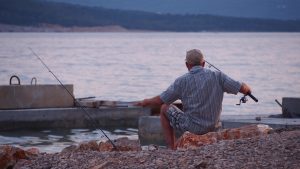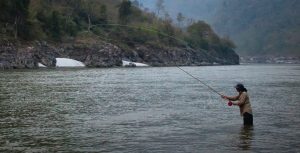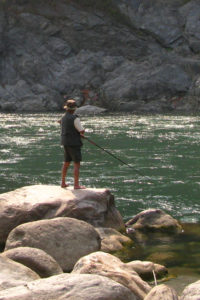What really amazed me was to see those intrepid rafters’ “natural ability to turn hardship into promise, to find humour in deprivation.”
“What on earth are these guys doing on this boulder-ridden fast river . . . surfing?” I asked myself incredulously, as I watched the distant two figures floating down the river—on their feet! I hastily retrieved my fishing line—and waited with bated breath, my camera at the ready. As it turned out, they were on some kind of a flimsy raft. And then, I froze—because one of the guys fell overboard in the rapids.

“There he is”, I almost cried out as I saw him—rather his upper body, hanging onto to one end of the bouncing raft as the choppy waters slapped him. He tried to climb … fell … tried again … slipped, and fell again. Then, I lost him between the leaping waves. Damn! I started almost praying as I furiously clicked away on my camera.
But I jumped, next! I saw him again. With half his body below water, he was still struggling.

“Come on, come on, you can do it, buddy!” I mumbled to myself. And then—a miracle, he clambered aboard! I waved madly at them as they came bobbing up and down and shot past me almost at arm’s length.

I was a witness to the above fateful drama way back in March 2008 at the confluence of the Sun Koshi and Tamur rivers at Trivenighat, Chhintang village, Dhankuta district. I was on a fishing trip to a village called Mai Beni, in the lower hills of Bhojpur, east Nepal, some 550 km from Kathmandu. I learned later that those guys were local villagers ferrying bamboos down the big river to sell.
The rafters lash together the bamboos in bunches of 25 to 30 stalks by a jungle vine locally called birali and stripped bamboo-skins called choya and shape it into a cone to serve as a raft, an ingenious skill handed down to them for generations. On arrival at the destination, the trussed up bamboos are taken apart and sold.

The rafters choose the river because the distance is twice less over the foot trail. Anyway, lugging the bamboos across narrow treacherous trails (almost over 30kms) is anything but possible. The river journey is by no means a smooth sail, however.
Nepal’s Sun Koshi(literally, the river of gold)—a glacier-fed river rises in the Himalayas near the Tibetan border(China) and turns steeper, faster and rockier—with boulders the size of trucks—and massive rapids as it winds down the mid-hills.
Removed from civilisation
Mai Beni (literally river confluence of the God) stands on a slope of a sparsely wooded hill that juts out to the confluence of two rivers, the Arun and the Sun Koshi (locals also call it Dudh Kosi). With only a handful of houses for habitation and insignificant cultivation, the hillside at the time appeared far-removed from civilization—seemingly back of beyond. There was no motor road to Mai Beni, only a 4-hour foot trail hewn into the side of hills—only a couple of feet wide at some places—with more than 500m drops.
And the bumpy ride to the start of the trail, Baraha Chhetra (20km from Dharan), in a battered locally-run Landrover overflowing with people—in and above on the roof—along the narrow dirt road that fell away on its side to several hundred feet into the Sapta Koshi (literally, seven rivers), was like leaving everything to fate.
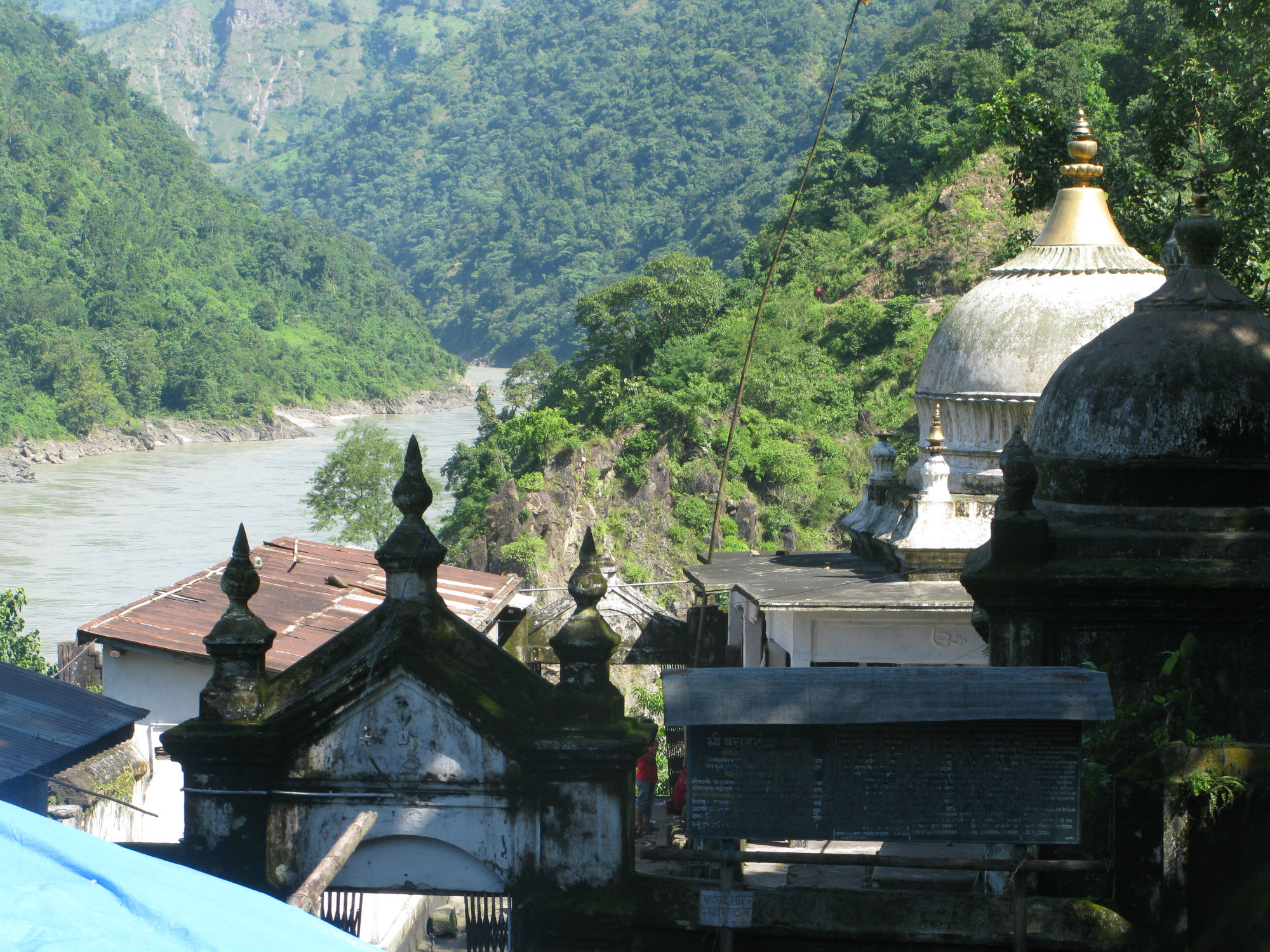
In Mai Beni I was a guest at Beni Kanchha’s (Kanchha, for short), a thatched stone-and-mortar house that looked out to the Sun Koshi, some 100 meters away. In his late thirties, Kanchha, an ethnic Rai, looked the perfect native hill people of Nepal, strong and sinewy.
A father of two, a girl aged 13, and a boy still a toddler, Kanchha farmed a few crops in his little land, raised goats and chicken, fished and, besides, ferried bamboos down the Sun Koshi. His wife, Kanchhi, juggled the household chores, the children and, in between, helped Kanchha.
A great fishing guide and enjoyable company, Kanchha surprised me as a gifted story-teller too. And one night as I rested in his house in the dim light of a wick lamp—mercifully relieved of the hot and humid day’s fishing—Kanchha sat cross-legged and narrated anecdotes about his 23 years at the river, fishing and ferrying bamboos. And one story, in particular, made me relive the drama I witnessed a few days ago. The deep resonant rumble of the nearby Sun Koshi kept us company.
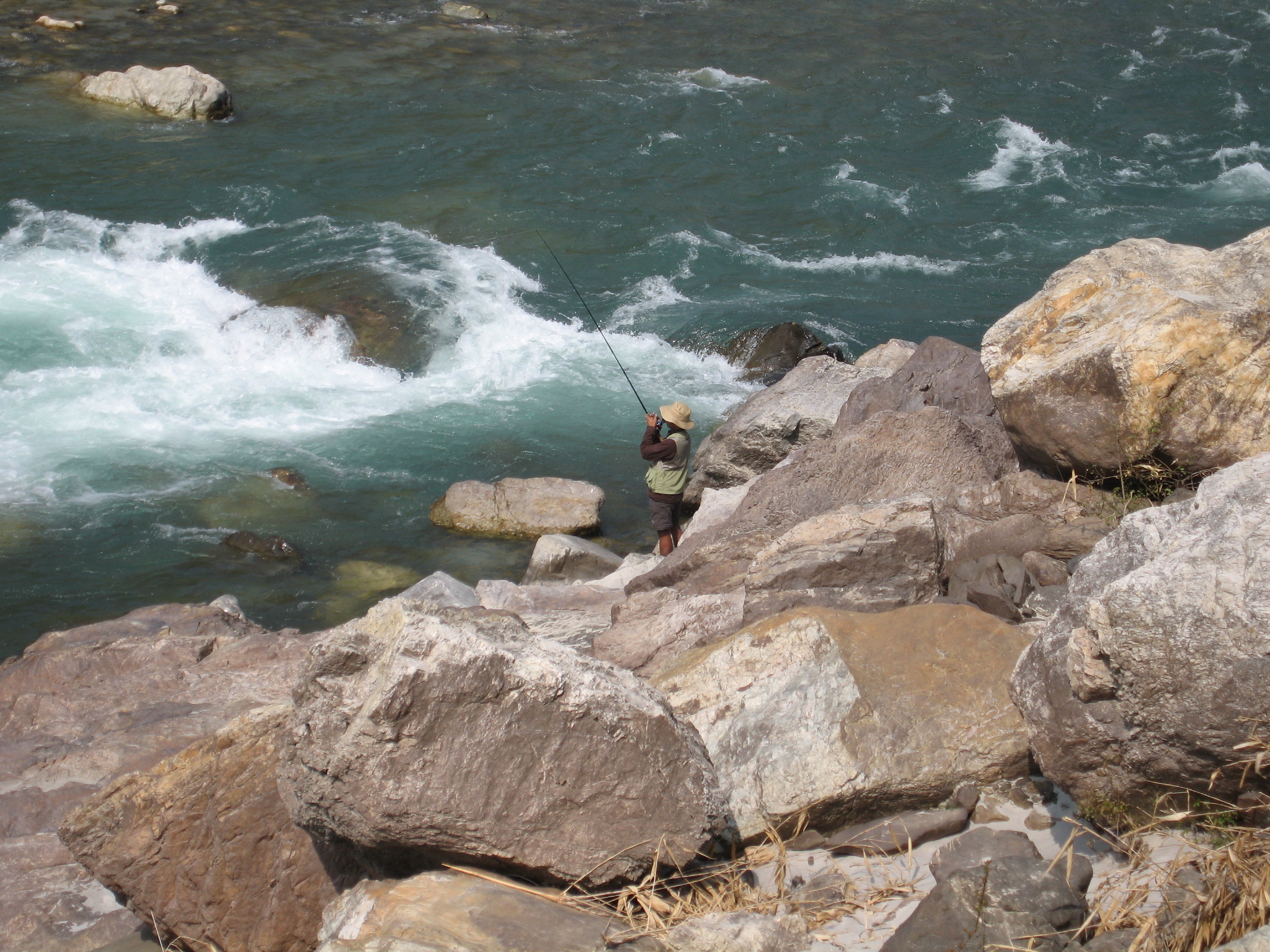
That October day in Mai Beni for Dan Bahadur Rai—Beni Kanchha, to fellow villagers—began as any other.
Beni Kanchha and his mate Nabin Rai were preparing for a long trip to Terardi Ghat(riverside bamboo yard) near Chatara bazaar to sell bamboos. They were set on ferrying 225 ghans (stalks; technically ‘culms’) as against the usual 150 to 180 ferried at a time by most rafters. Another friend, Man Bahadur Majhi joined them as a helping hand as the load was larger than the usual.

After two hours of hard work of tying up the bamboos, the raft was finally water worthy. Kanchha made double sure that the knots were tied down firmly and the charis, the 35 foot bamboo poles used for steering the raft, in good shape.
After a hurried dal/bhat, the trio set sail. The journey back would take them more than six hours on foot. None relished the idea of stumbling on the trail after dark on their way back home.
The sky was a brilliant blue and the sun bright with no noticeable wind. The post-monsoon water level was high but calm. A perfect day, thought Kanchha as he looked up at the cloudless sky and then at the turquoise Sun Koshi.
“Ah-ong”, “ah-ong”, the honk sounded, as a pair of Brahmini ducks (ruddy shelduck) took flight from the opposite bank, circled and flew low overhead, proudly displaying their dashing plumage of fawn-orange, cream, grey, green and black against the blue sky. Kanchha always loved to watch them fly.
Facing the rapids
Within 10 minutes, the trio arrived at the first rapid. Kanchha gave a cautioning shout and rammed his chari into the churning water—his mates followed suit. Huge sprays slapped the three as the raft climbed the waves and then dived into the white water. But just moments later, it shot out—safe. Phew! Nabin whistled in relief. The first hurdle was over—three more to go.
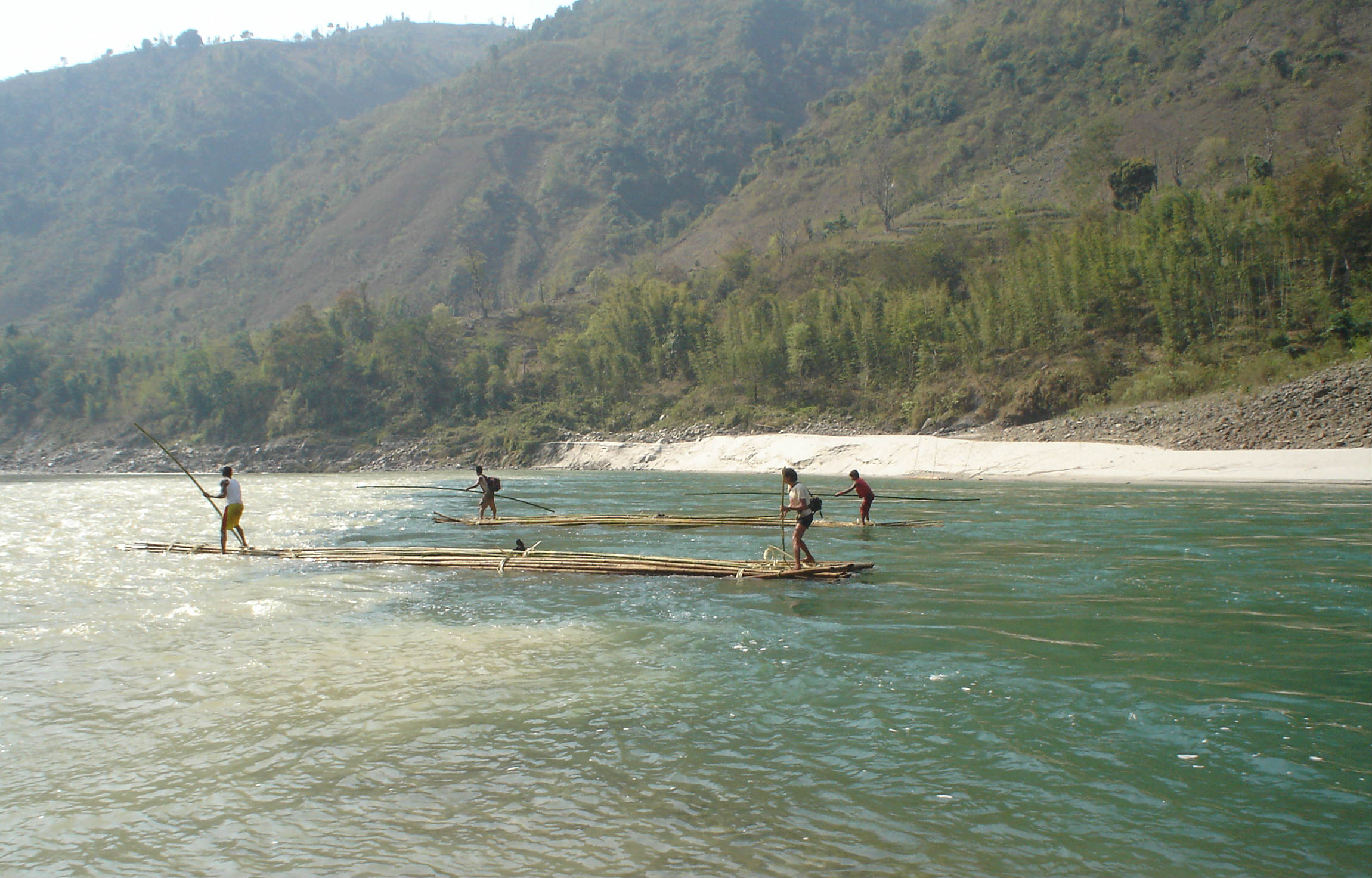
The trio relaxed as the raft steadied on placid waters. Time for some tobacco, decided Nabin and reached for the plastic pouch in his pocket, and started rubbing some into his palm. Kanchha lighted a cigarette instead and regarded the approaching confluence, where the powder-blue Arun tumbled into the larger Sun Koshi.
He waved at the local boys on the right bank, who were hurling their hand-cast lures for mahseer(a prized game-fish) into the water. The fishers shouted back their greetings.
The Sun Koshi-Arun confluence posed no threat for the rafters. Kanchha’s main concern was the next confluence, some 200 meters down, where the rock-strewn fast running Tamur rushed to meet the swollen Sun Koshi (after Arun drains into her). The bigger and wider river after this point is called the Sapta Koshi( a merger of seven rivers) and flows south over vast plains into Bihar, India, to finally drain into the Ganges.
For the trio, the dreaded moment had arrived. As they drifted close towards the confluence, they peered apprehensively ahead at the tiny speck rapidly looming up–the jyanmare dhunga, literally, “the killer boulder.”
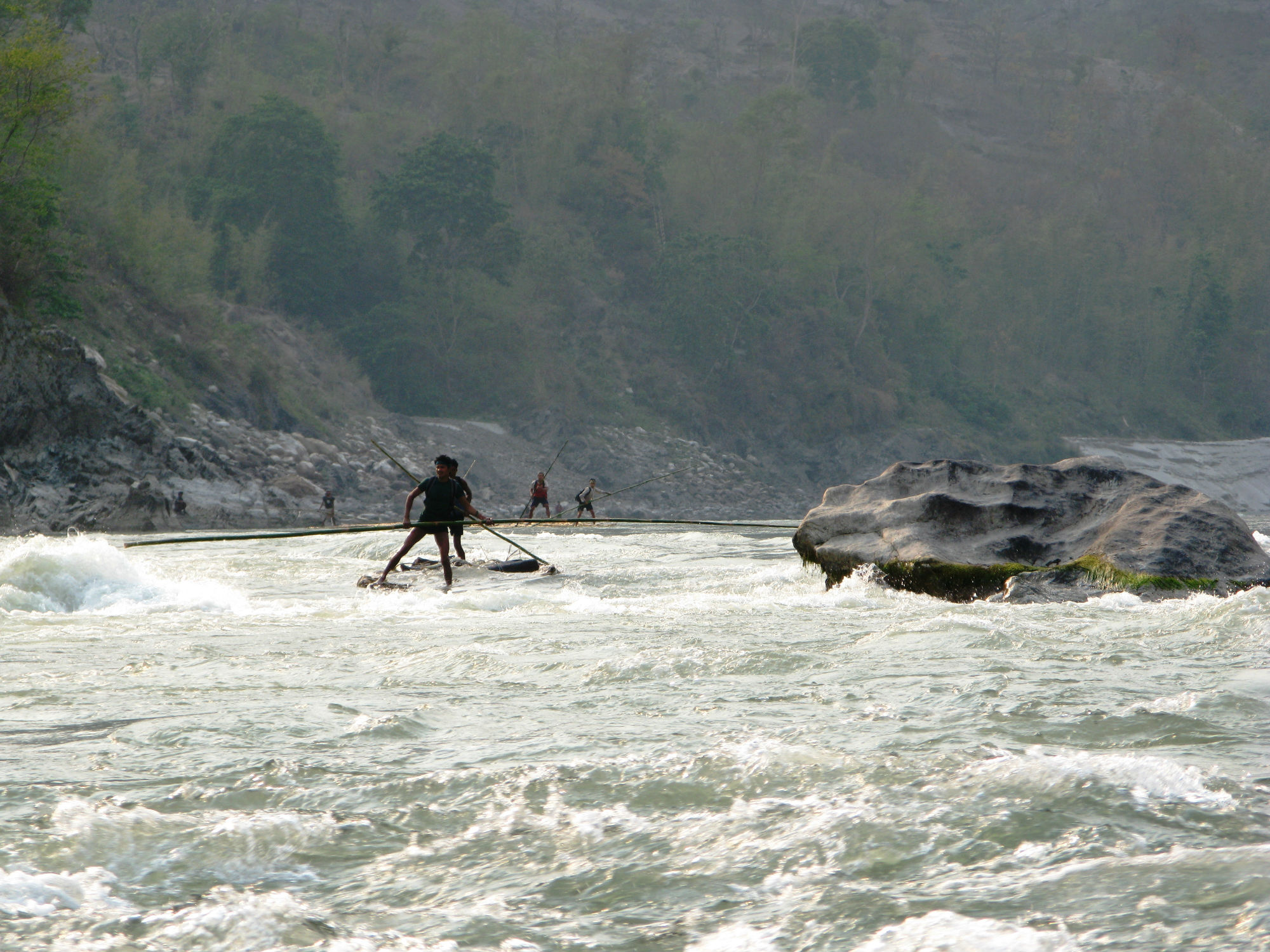
Christened thus by the bamboo rafters, the massive boulder surrounded by smaller ones juts out almost 4 ft above the crashing waters, next to where the Tamur pours into the Sun Koshi.
It also happens to be one of the most treacherous rapids held in awe and fear by the rafters—and long the site of innumerable accidents, resulting in serious injuries and even deaths.
Now, the threesome needed to hold the heavy and sluggish raft at arm’s length from the killer boulder, meet headlong the force of the Tamur and then swerve quickly to their right to dodge the smaller boulders hidden beneath the thrashing waters.
“Here, a rafter’s sheer grit, experience and the best of his prowess are put to the test”, Beni Kanchha explained
They were ready. Kanchha yelled out the instructions as the raft rode the white waves and then nosedived.
Kanchha suddenly realized that the current was way too strong for the unwieldy raft (larger than the normal size), which forced them dangerously close to the killer boulder. All three plunged in unison their charis and gathered their full strength to push the raft away. Try as they might, the raft seemed to veer off course.
Cheating death
Fear gripped Kanchha—but before he could shout another warning the speeding raft dashed full force into the dreaded boulder, hovered for a few seconds, and then was hurled like a matchbox towards the waiting rocks on their right.
Despite the deafening roar, Kanchha clearly heard the cracking thud at the first direct hit followed by a second. Both the birali creepers and choya strips snapped, and horrified, he watched the raft split clean in two. Even before he knew, the waves washed him overboard—his mates, too.
“I kicked furiously and luckily managed hold on the broken raft. Fearing for my friends’ safety, I held on,” Kanchha recalled. “Suddenly the raging water tipped the split raft over carrying me underneath. Everything blackened. A deafening rumble like a hundred strong truck engines filled my ears. Trapped underwater for what seemed like ages, I fought hard, my lungs to bursting”.
Kanchha stopped to regain his breath, as if the recollection made him difficult to breathe.
“Then, I panicked. The first face that zoomed before my eyes was that of the man I owed the balance money for the bamboos. Then—all in a flash—it was my little son, daughter and Kanchhi, my wife. This is the end, I thought.”
“I don’t know what it was, must be God’s will—I suddenly surfaced. I somehow clambered on to the broken raft and saw, to my great relief, my mates drifting on the other half some 150 meters downstream.”
Help soon came from other fellow rafters who helped them to the nearest bank. After a brief respite, they fetched some birali vines, re-tied the split raft together and continued onwards to Terardi Ghat, still a long way.
They had to navigate two more treacherous rapids that lay ahead but, fearsome or not, they also had to be run. All went well, however, and the rest of the journey proved uneventful. When they finally reached Terardi they were three hours behind—and pitch-dark when back home.
This is how the bamboo rafters flirt with death on every trip down the Sun Koshi. Mishaps are common and the unpredictable river lays claim to one or two rafters almost every other year. Kanchha, then 37, started when he was 14, and he has had a close brush with death several times. Some others were not lucky enough to tell their tales.

During my visit, the bamboo trading down the Koshi was done mostly by hard-working men of ethnic Rai, Majhi and Tamang community. All they saved was 10 rupees per stalk.
Living below poverty level, the lives of riverside natives in east Nepal was agonizingly hard. In the later years, far fewer numbers were in this trade in the wake of massive exodus of Nepalese youth to the Middle East and Southeast Asia seeking employment.
I travelled to Mai Beni for three more years (took a life-jacket as a gift to Beni Kanchha the second year) and witnessed those dare-devil rafters, bound by tradition and poverty, braving the rapids ferrying bamboos down the Koshi—unaided by any kind of life-saving gear. For the villagers, it was as much a means of livelihood as pig farming, raising goats and chickens, fishing and cultivating a few crops on the harsh countryside.
What really amazed me was to see those intrepid rafters’ “natural ability to turn hardship into promise, to find humour in deprivation.”




